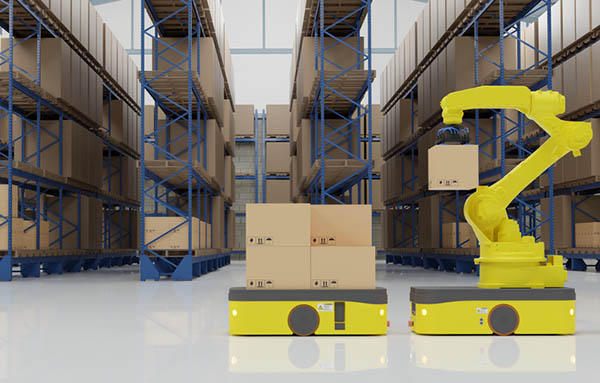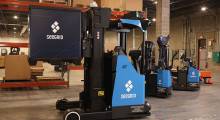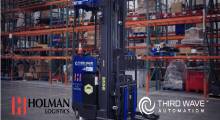The term “material handling” refers to the controlling, moving, and protecting of products and materials from production to distribution. In some cases, in-between processes such as transportation and storage are included as well. Material handling equipment includes a wide range of automation technologies, with conveyor systems and mobile robots being some of the most common ones.
As materials handling involves packaging, storage, shipping, and delivery, it is closely tied to the manufacturing, warehousing, logistics, retail, and disposal industries. To be more precise, Meili Robots has identified four stages of material handling processes in the supply chain:
- Manufacturing: First, inbound shipments of components and finished goods need to be moved and handled within factories and storage facilities.
- Transportation: Second, the goods need to be transferred to either an internal warehouse or to an external wholesaler — preferably as units, to smoothen the shipping process.
- Warehousing and storage: Now it is time for the products to be offloaded, moved, and stored in racks or shelving units within the warehouse.
- Distribution: Finally, the products need to be picked, sorted, and packed into units, and loaded onto trucks in order to be distributed to retailers or customers.
Unsurprisingly, material handling has become an absolutely essential part of today’s supply chain management as well as optimizing warehouse efficiency — and the market’s growth numbers speak louder than words.
Material handling market grows
Even before the COVID-19 pandemic, consumer behavior had been shifting more and more toward online shopping. Material handling automation has become increasingly important for businesses to efficiently fulfill orders and stay competitive during supply chain disruptions.
As the table below shows, statistics of the global material handling market show tremendous growth potential. Being currently valued at just over $27 billion (U.S.), Grand View Research predicted that the market to grow to a value of more than $43 billion by 2028, following a compound annual growth rate (CAGR) of 7.4%.

Manual vs. automated material handling systems
In general, we can distinguish between two types of materials handling processes—manual and automated. While human labor is flexible and established throughout global supply chains, workforce challenges such as retention, salaries, and local availability have led many operations to consider robotics.
Let’s have a look at the pros and cons for each of these approaches:
Manual material handling:
- Pro: The initial investment is low when it comes to machinery and technology.
- Pro: As technical expertise is not needed, it is relatively easy for employees to adapt to new processes.
- Pro: There is greater space availability, as no heavy equipment or machinery is involved.
- Con: To avoid injuries, regular safety training is needed.
- Con: Such processes are prone to human error.
Automated material handling:
- Pro: Increased flexibility allows for adjusting processes as needed.
- Con: The initial investment is high, but automated systems could save a large amount of money in the long run.
- Pro: The risk of injuries and accidents is reduced, as there is no need for employees to lift heavy materials
- Pro: Space can be utilized more efficiently thanks to machinery that, for example, can store products in higher places.
- Pro: Automation can helps minimize errors in inventory management, thereby improving order fulfillment.
As is the case with most technology, the exact system that works best for your business will depend on several factors such as the future plans for your business and your initial budget.
Whereas manual systems work just fine for relatively small businesses that work with dynamic process handling, robots and automation are great for businesses that deal with many repetitive tasks and larger volumes of materials.
Four ways to optimize material handling
For businesses wanting to optimize their material handling processes, the following steps could be a useful starting point:
- Evaluation: Regularly evaluate the state of your processes based on data related to your operations. Think about the numbers of orders processed, how many forklifts are being used and what their operating costs are, the overall cost of running your facility, etc. This will help you understand where adjustments should be made.
- Automation: Consider automation to optimize the efficiency and profitability of your facility. Robots and software can not only help save a lot of time, but thanks to their ability to predict and respond to order fulfillment as well as materials flow, they can also reduce operational costs.
- Storage and flow: If you want to optimize your warehouse design, you will first need to have a deep understanding of your processes. To do so, it is essential to analyze the movement of materials to and from different locations across your facility. This will also help determine which solution works best for your requirements.
- Intelligent storage: By implementing a storage system that uses artificial intelligence to constantly learn and adapt to the environment, businesses can easily predict and respond to materials flow, thereby optimizing the movement of goods throughout their facilities.
The importance of task management and navigation
As we have seen throughout this article, materials handling automation can be a great way to optimize flow of materials across production, storage, and distribution facilities. If you are using—or plan to use—automated guided vehicles (AGVs) or autonomous mobile robots (AMRs), you may want to consider systems to manage safe navigation and task assignment in dynamic environments.
Interoperability has arisen as a concern over the past year or so, as factories and warehouses begin to deploy robots from multiple suppliers.
A universal fleet management system such as Meili FMS can help mobile robot fleets to work effectively, especially if the fleet consists of different types of robots. Not only does will this software allow you to centrally manage your robots, but it can also enable them to autonomously and automatically adjust to changes in your order fulfillment.

About the author
Michelle Schlechtriem is the content manager at Meili Robots. She writes about marketing, technology, and sustainability.
Meili Robots' Meili FMS system is designed to allow robot operators to handle different types and brands of AGVs and AMRs in one system. It can be used for planning, assigning, and executing tasks through key features such as mapping, data logging, and data analytics, according to the Copenhagen-based company.
Article topics
Email Sign Up
















